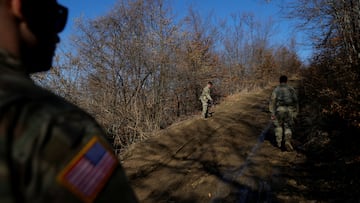How big are the armies in Europe and which are the biggest? How big are the combined forces of NATO?
After the Cold War, European armies shrank. Where do they stand now with the largest land war in Europe since WWII?

A notable feature of the conflict between Ukraine and Russia has always been the power imbalances between the countries regarding their military power. After the full-scale invasion of Ukraine by Russia two years ago, members of the North Atlantic Treaty Organization (NATO) made clear that they would not get involved directly but would support the Ukrainian government with weapons, military training, and bolstering the defense of other allied countries in the region. Down the line, NATO leaders see Ukraine as a future member of the defensive alliance.
"Ukraine will join NATO. It is not a question of if, but of when." NATO chief Jens Stoltenberg says Kyiv's future lies in the Western defense alliance. pic.twitter.com/8HYh79NIPl
— DW News (@dwnews) February 26, 2024
After Russia, the next four largest military forces in Europe belong to NATO member countries. According to the Independent, a UK-based paper, the combined forces of all NATO member armies totals around 3.5 million soldiers and personnel.
Which are the largest militaries in Europe?
Before the end of the Cold War, Western European nations allocated an average of 2.4 percent of their GDP to military spending. However, by 2020, this percentage had decreased to just 1.6 percent of GDP. Nonetheless, the reduction in the size of each nation’s armed forces was not uniform, and since Russia’s invasion, it has begun to grow once again.
During the Cold War era, Germany was on the front line of the Iron Curtain and had the largest standing army in Europe. The western portion of Germany was followed by Italy, France, and Britain in terms of military strength. However, the military landscape has changed over the years, and France now has the largest military force in Europe after Russia. The UK, Italy, and Germany follow France in the ranking of military strength.
We are ready, we are capable, we are NATO. #strongertogether pic.twitter.com/c4vQCvmhXe
— SHAPE_NATO Allied Command Operations (@SHAPE_NATO) February 26, 2022
The downsizing of military spending occurred in Russia as well. However, around 2009, spending picked up again, according to the Stockholm International Peace Research Institute (SIPRI) data. Last year, NATO estimated that average military spending as a portion of GDP among NATO members grew to 2.64 percent, but at 1.82, the median still fell under the two percent goal for each member.
How big are the standing armies in Europe?
As a single nation Russia has the largest force of a European nation with 850,000 active personnel, or ready to deploy. They have another half million that they could call upon on short notice. However, Russia doesn’t have the most troops in the world, that title goes to China. However, Russia must also protect a vast area covering around a tenth of the Earth’s land.
For comparison, according to Global Firepower, France has 205,000 active personnel, the UK 194,000, Italy 170,000, and Germany 184,000. However, the combined number of troops that NATO can call on is close to 3.4 million, with another 2 million reservists and paramilitary forces, according to Statista.
Related stories
Ukraine began the war with a sizeable fighting force consisting of 200,000 active personnel and around 500,000 reservists and paramilitary forces are included in the count. In the current conflict, the nation has called on all males 18 to 60 years old to take up arms and has barred this group from leaving the country. However, conscription into the army is only mandatory for those twenty-seven and older, though the government is seriously considering lowering this number to twenty-five as they encounter significant and lasting challenges on the battlefield. In December 2023, Ukrainian Presidnet Volodymyr Zelenskyy said in a public address that his military commanders had asked conscription to be increased substantially, believing it necessary to bring between 450,000 and 500,000 more men into the fight.
This news comes as the United States Congress has scaled back its support for Ukraine. Already, the lack of military assistance is impacting the battlefield, helping the Russian Army seize control over new land or retake areas that had previously fallen back into Ukrainian hands. While other NATO members have attempted to fill the gaps left open by the United States, the efforts have not been great enough to overcome the tactile impacts on the battlefield.

Complete your personal details to comment